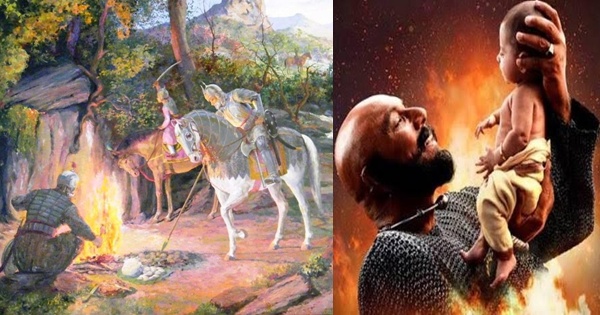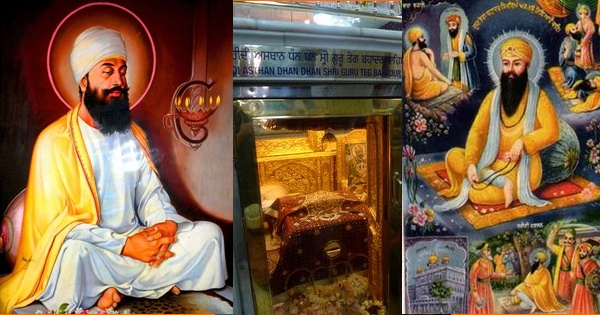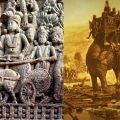The Real Kattappa of Indian History; Loyalty Personified

The movie Baahubali was a grand success and almost everybody is familiar with the characters of this magnum opus. Kattappa is portrayed in the movie as a man who is fiercely loyal to the royal throne of Mahishmati and will do anything to preserve it and protect it. Kattappa is an embodiment of the fiercest bravery, valor and loyalty.
In real life, such a selfless man as Kattappa is very hard to find. But are you aware, that in Indian history there was a man who had all the qualities of Kattappa? He was a fierce warrior, a very able strategist and loyal to the extent that he spent all his life saving the royal family he served and kept it safe when it was in grave danger of becoming extinct or converted to another faith. This man never assumed power although he was revered even more than the king.
This man was Durgadas Rathore who protected and served the royal family of Jodhpur and kept the Marwar flag flying high when it was in dire straits. He is the real Kattappa of Indian History!
Durgadas was born in a smaller noble family of Jodhpur on 13 August 1638. His father Askaran Rathore was a minister in the royal court of Jodhpur, the then capital of Marwar. Jaswant Singh was the Maharaja of Marwar. Durgadas had shown his valor and courage in many battles. He was in the good books of the Maharaja. By this time, Marwar had accepted the sovereignty of the Mughals and Jaswant Singh was made the prime commander of the Mughal army of Aurangzeb. Jaswant Singh was sent by Aurangzeb to quell the revolt of the Afghans in Kabul, Afghanistan. Here, he breathed his last in 1678 near Peshawar. At the time of his death, two of his queens were pregnant.
Aurangzeb was a clever fox who never lost a minute in annexing a state in such situations. He declared Marwar as a jagir of Mughal empire and installed Indra Singh Rathore, a nephew of Jaswant Singh as its ruler. Aurangzeb personally moved from Delhi to Ajmer to oversee the operation.
Both the pregnant queens of Jaswant Singh gave birth to sons. Now to quell any dispute, Aurangzeb ordered Rathores to send both the queens and sons of Jaswant Singh to Delhi. He assured that he would take care of them and would allot a jagir to the elder of the two. The elder son of Jaswant Singh was named Ajit Singh. Pretty soon, the younger brother of Ajit Singh died leaving him as the sole heir of Marwar. Rathores had to reluctantly obey the Mughals as Marwar was under control of Aurangzeb’s stooge Indra Singh. Both the queens and infant were brought to Delhi and kept at the Rathore mansion in Shahjanabad (Old Delhi).
Prominent Rathore leaders and noblemen of Jodhpur went in a delegation led by Durgadas Rathore to plead for Ajit Singh to be named as the royal heir and Maharaja of Marwar. Aurangzeb repeated his promise of giving a jagir to Ajit Singh with the title of Raja when he attained age. The Rajput nobles persisted their demand of giving the throne of Marwar to Ajit Singh. Now Aurangzeb put forth his next cunning move; he promised he would give the throne of Marwar to Ajit Singh only if he converted to Islam and raised as a proper Muslim in his harem.
The Rathores under Durgadas saw through the ploy and retired to their mansion seeking time to think. It was 25th June 1679. Durgadas decided to take both the queens and the child to Jodhpur even at the risk of their lives. A servant girl was left at the mansion with her child disguised as Ajit Singh. Both the queens disguised in male attire and the delegation moved out on the treacherous way to Jodhpur from Delhi. Aurangzeb was quick to react and sent his soldiers to capture Durgadas and party.
Durgadas quickly took control of the situation and used gunfire to stop them dead in their tracks. With this obstacle removed, the small band of Rathores started on their perilous journey towards Jodhpur. The Mughals were not so easily giving up on them and they soon started following them at a breakneck speed. Durgadas was in a dilemma as the Mughals were fast catching up on them. Now he had to think fast and act fast. As they were moving towards Jodhpur, Rathores under him devised a scheme to slow down the progress of Mughals chasing them. Few of them stopped and laid an ambush. The Mughals arrived and had to fight their way through this very small party of Rathores. The Rajputs were outnumbered hugely, but this gave the much needed extra time to the fleeing party ahead of them.
The Mughals kept pursuing them; after few miles, the Rathores again followed the same scheme and some of them again sacrificed their lives to keep the heir alive. Several repetitions of this scheme until the party comprised only of Durgadas, infant Ajit Singh, the queens and three other Rathore nobles. They reached Balunda; here one of the families of the nobles gave shelter to the queens and Ajit Singh at the same time pledging to protect them even at the peril of their lives. Durgadas and the others vanished into the Aravalis to carry on their struggle of placing Ajit Singh on throne.
A furious Aurangzeb, facing failure, decided to teach the Rathores of Jodhpur a lesson. He captured the boy left behind at the mansion in Shahjanabad and claimed that he had caught Ajit Singh. He converted the boy to Islam. This was done in order to fool people of Marwar that the real Ajit Singh was an impostor.
Aurangzeb ordered his son Muhammad Akbar to occupy Marwar so as to fully integrate it into the Mughal dominion. Akbar moved on to Marwar, commanding a considerable army. Ajit Singh’s mother was a Sisodia and from the royal family of Mewar. Through her coercion, Maharana Raj Singh of Mewar decided to help the Rathores. But the combined army of Rathores and Sisodiyas was greatly outnumbered by the Mughal forces. They faced defeat in the open battle field and was forced to retreat to the Aravalis. Durgadas was the leader of Rathore faction. Maharana Raj Singh withdrew his Mewar army towards his own province as he feared a direct assault by Mughals on his kingdom. But, he continued to support the Rathores by actively engaging in guerilla warfare by looting Mughal camps and attacking and disrupting their supply lines. Durgadas Rathore and his followers too continued to do the same.
Aurangzeb was fed up of this and imposed jaziya tax on Marwar. He devastated numerous Hindu temples and shrines. For 20 years, Marwar remained under direct Mughal occupation. Meanwhile, Ajit Singh was sent by Durgadas to Sirohi, a remote town on the borders of present Gujarat and Rajasthan. Here he continued to live without Mughal harassment. Durgadas himself trained the prince on the art of warfare. They waited for the right time to take back the throne of Marwar. Kattappa of Mahishmati did the same to save prince Baahubali.
The Mughal empire was severely affected by the Rathores’ guerilla tactics. Durgadas attacked treasuries and looted the Mughals and did not let them rest. It was a time when the Mughals were also being threatened by the Marathas in the Deccan. Aurangzeb decided to send his sons Azam and Muazzam to support Akbar and bring Rathores to their knees. Durgadas was quick to understand the gravity of the situation. He secretly started parleys with Muhammad Akbar and incited him to revolt against his father. He promised him full help in his endeavor to become the Mughal emperor. Akbar was told that policies of Aurangzeb were actually harming the Mughal empire by eroding its support. Akbar on the behest of Durgadas, declared himself emperor in an open rebellion.
Aurangzeb was a wily character; he devised a scheme so as to create discord between Akbar and his Rajput allies. He was successful in this and Akbar had to run away. Akbar later was able to convince Durgadas that the rift caused among them was a scheme of his father Aurangzeb and Durgadas again started supporting him fully. As Rajput forces were not enough to install him as emperor, Durgadas took him to Deccan to meet Sambhaji, the Maratha king. Akbar lived there for many years hoping for Maratha aid. His two children, a son and a daughter were under Durgadas’s care who in spite of the schemes and treacheries of the Mughals arranged for their education and raised them as Musalmans. He could have easily converted them to Hinduism but such was the greatness of Durgadas that he did not do so.
Akbar later fled to Persia to garner support for himself but died soon after. After Akbar’s death, a peace treaty ensued between Rathores and Aurangzeb. The children of Akbar were handed back to the old emperor who was amazed to find them to be raised in proper Islamic way.
Soon after, Aurangzeb died. This gave perfect opportunity to Durgadas to capture Jodhpur and whole of Marwar. He succeeded! He installed Ajit Singh as the Maharaja of Marwar thus fulfilling his duty and promise as custodian of the Rathore royal family.
Durgadas then left Jodhpur and lived in Sadri, Udaipur, Rampura, Bhanpura for some time and then left for Ujjain to worship Mahakaal. On 22 November 1718, on the banks of the Shipra at Ujjain, Durgadas finally breathed his last at the age of 81 years. His canopy in red sandstone is still at the Chakratirtha, Ujjain, which is a pilgrimage for all those who like the virtues of loyalty and bravery.
So, this was the real Kattappa of Indian history of whom we all never read in our history books. This again brings us to this question as to why such personalities are left out?

The Indian government has issued stamps and coins in honor of Durgadas.
Also Read: Nag Bhat I, the Gurjar Pratihar King Badly Defeated Arab Forces; We Were Not Taught This.
Facebook Comments Box
The following two tabs change content below.

Yogaditya Singh Rawal
National level competitive bodybuilder, Mr. India 2016 (Federation Cup Bodybuilding), Certified Fitness Trainer (ISSA-USA), Performance Nutrition Consultant, Diet Consultant, Writer, and Practitioner of Ancient Indian Battlefield Art 'Sanatan Shastra Vidya'. He runs a gym (Total Training Terminal) in East Delhi.






